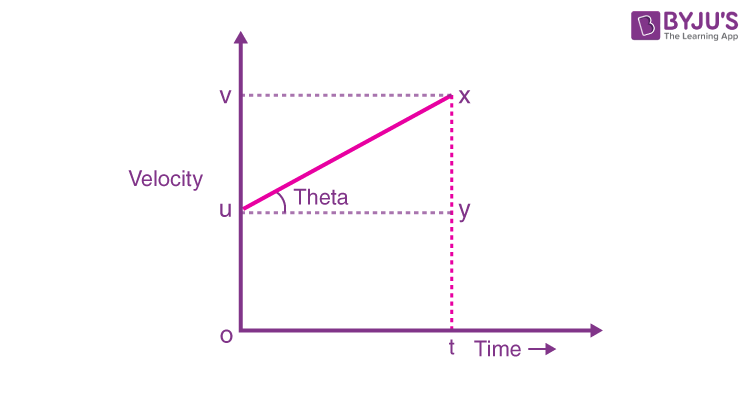As we know, motion is the phenomenon in which an object changes its position. Motion is represented in terms of displacement, distance, velocity, acceleration, speed, and time. Let us know the equations of motion, and applications of the equations of motion.
| Table of Contents: |
Introduction to Equations Of Motion
In this article, we will learn how we can relate quantities like velocity, time, acceleration and displacement provided the acceleration remains constant. These relations are collectively known as the equation of motion. There are three equations of motion. There are three ways to derive the equation of motion and here we are going to derive with the help of a graph.

Read More: Derivation of Equation of Motion
First Equation of Motion
First equation of motion relates velocity, time and acceleration. Now in ∆uxy,
We also know that tanθ is nothing but the slope, and slope of the v – t graph represents acceleration.
⇒ v = u + at ———– (1)
This is the first equation of motion where,
v = final velocity
u = initial velocity
a = acceleration
t = time taken
Second Equation of Motion
Now coming to the second equation of motion, it relates displacement, velocity, acceleration and time. The area under the v – t graph represents the displacement of the body.
In this case,
Displacement = Area of the trapezium (ouxt)
We can substitute v in terms of others and get the final equation as:
Where symbols have their usual meaning.
Third Equation of Motion
The third equation of motion relates to velocity, displacement, and acceleration. Using the same equation (2),
Using equation (1), if we replace t, we get,
The above equation represents our third equation of motion.
Read More: Displacement
Applications of Equations of Motion
So now that we have seen all three equations of motion, we can use them to solve kinematic problems. We just have to identify what all parameters are given and then choose the appropriate equation and solve for the required parameter.
The equations of motion are also used in the calculation of optical properties.
The Fundamentals of Motion: Understanding the Laws of Physics

Frequently Asked Questions – FAQs
What is motion?
Motion is the phenomenon in which an object changes its position.
What is the first equation of motion?
The first equation of motion is given as:
v = u + at
Where,
v = final velocity
u = initial velocity
a = acceleration
t = time taken
What is the second equation of motion?
The second equation of motion is given as:
v = final velocity
u = initial velocity
a = acceleration
t = time taken
What is the third equation of motion?
The third equation of motion is given as:
v = final velocity
u = initial velocity
a = acceleration
t = time taken
What does the area under the v – t graph represent?
Important questions in the chapter Motion Class 9

Top 10 NTSE Important Questions on Motion Class 9

To learn more related concepts with the help of interactive video lessons, download BYJU’S – The Learning App.

It is very useful.